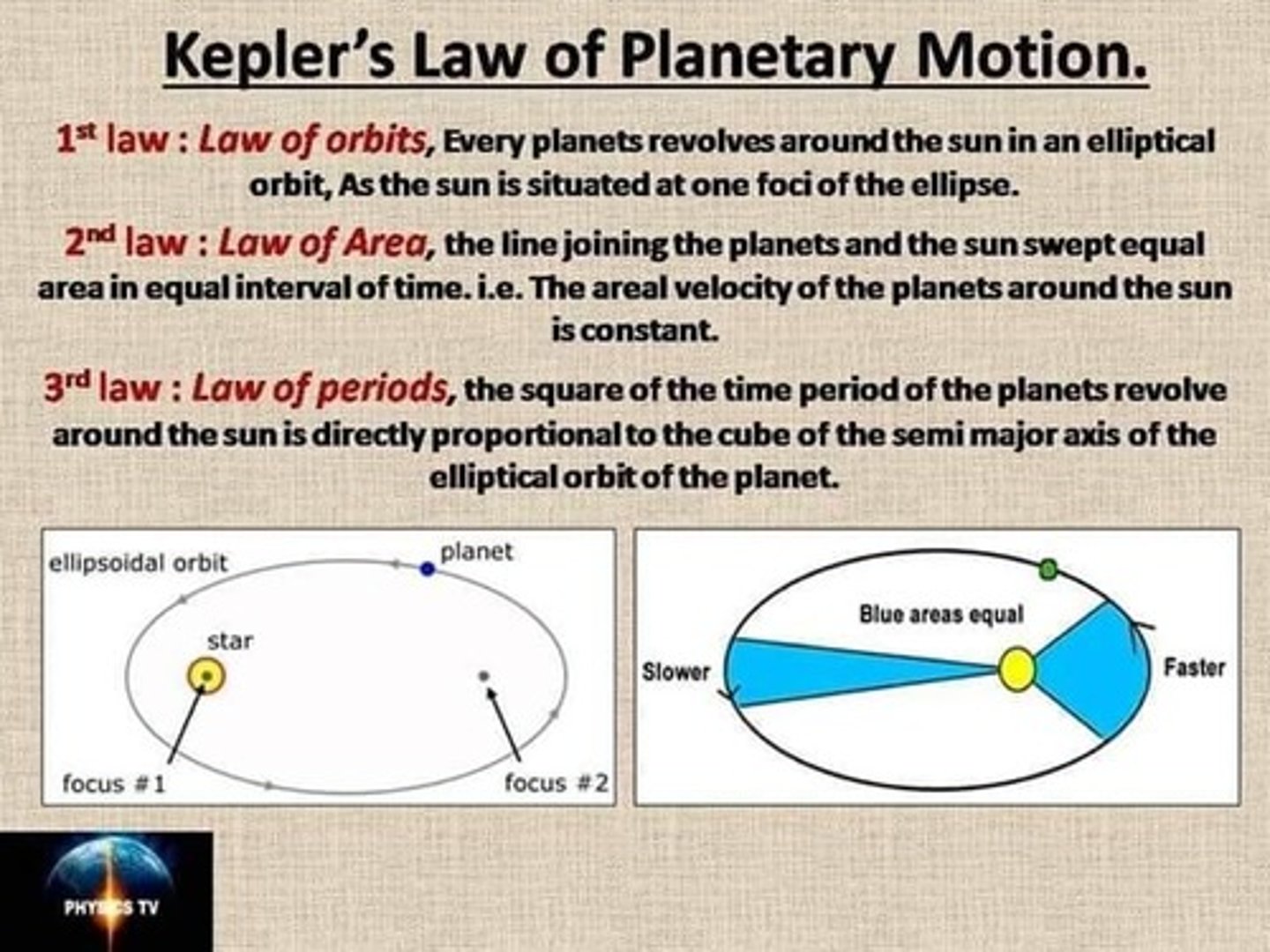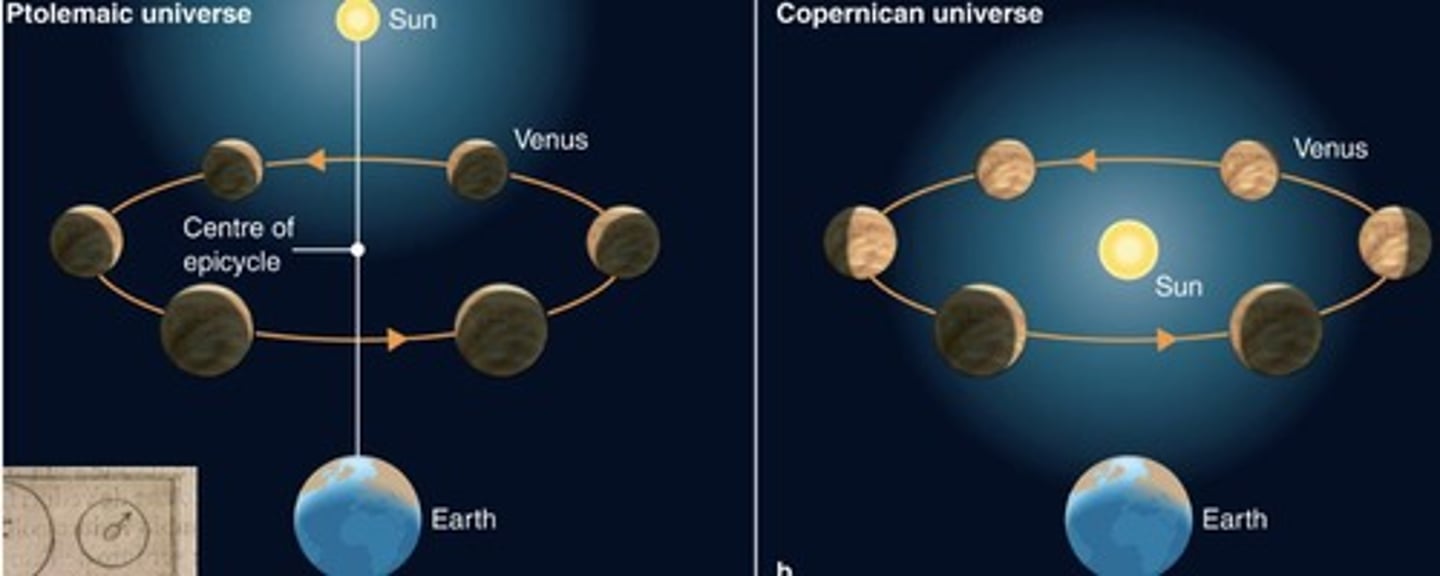Kepler's Laws and Early Astronomy Discoveries
1/112
There's no tags or description
Looks like no tags are added yet.
Name | Mastery | Learn | Test | Matching | Spaced |
|---|
No study sessions yet.
113 Terms
Ellipse
An elongated circle.

Foci
End of ellipse; they are points located inside the ellipse.
Location of foci
If the ellipse is nearly a circle, the foci are closer to the centre; if the ellipse is very stretched out, the foci are farther from the centre.
Eccentricity
A number that measures how much the ellipse shifts from being a perfect circle.
Eccentricity range
The eccentricity of an ellipse is always between 0 and 1.
E = 0
Perfect ellipse (circular).
E close to 1
More elongated or stretched.
Major axis
Longest diameter of the ellipse passing both foci.
Minor axis
Shortest diameter of the ellipse perpendicular to the major axis at its centre.
Semi major
Half of the major axis.
1st law
Planets don't move in perfect circles; their paths are slightly stretched-out circles (ellipses), and the Sun is off-center at one special point inside the ellipse.

2nd law
Planets move faster when they are closer to the Sun and slower when they are farther from the Sun; the area covered by the planet in its orbit in a fixed time is always the same.
Perihelion
When the Earth is closest to the Sun in its orbit, it moves fastest there.
Aphelion
When the Earth is the furthest away from the Sun in its orbit, it moves slowest there.
3rd law
The square of the orbital period of a planet increases as the cube of the semi-major axis of its orbit increases.
P
Period of revolution (orbital period in Earth years).
a
Semi-major axis (average distance from the Sun in AU).
1 AU
Earth's distance from the Sun.
Kepler's contribution
Kepler talked about the orbital period in terms of orbits per time, describing how many times a planet goes around the Sun in a certain amount of time.
Rudolphine tables
Published in 1627, they were the most accurate astronomical tables of their time, predicting the positions of planets and stars.
Significance of Rudolphine tables
They proved heliocentrism and laid groundwork for Kepler's laws, inspiring Newton's theory of gravity.
Galileo Galilei
Remembered as the father of the scientific method.
Galileo's observation of the Moon
He noted smooth, dark patches (cooled lava) and mountains, measuring heights (~7 km) using trigonometry.
Galileo's observation of the Milky Way
He proved it was countless stars, contradicting Aristotle's claim that it was an atmospheric phenomenon.
Planets vs. Stars
Planets appeared 100x larger through telescopes; stars remained point-like due to distance.
Galilean Moons of Jupiter
Names: Io, Europa, Ganymede, Callisto (originally called 'Medician stars').
Significance
First direct evidence not everything orbits Earth (contradicted Aristotle).
Ganymede
Largest moon in the solar system.
Phases of Venus
Venus shows crescent, gibbous, and full phases (like the Moon).
Proof of Heliocentrism
Phases only make sense if Venus orbits the Sun (not Earth).
Ptolemaic Model Failed
Could not explain Venus's full phase.

Sunspots
Dark, cooler regions (~1000°C cooler than the Sun's surface).
Significance of Sunspots
More evidence against 'perfect heavens.'
Starry Messenger (Sidereus Nuncius, 1610)
Published observations.
Dialogue Concerning the Two Chief World Systems (1632)
Mocked geocentrism (Pope's arguments voiced by 'Simplicio').
Inquisition (1633)
Forced to recant heliocentrism; sentenced to house arrest.
Galilean Refractor
Design: Convex primary lens + concave eyepiece.
How Galilean Refractor Works
Light refracts through glass lenses; primary lens concentrates light, eyepiece refocuses rays for the eye.
Limitation of Galilean Refractor
Narrow field of view.
Keplerian Refractor (Modern)
Design: Two convex lenses (inverted image).
Advantages of Keplerian Refractor
Wider field of view, brighter images.
Disadvantage of Keplerian Refractor
Image appears upside down; does not correct aberration.
Plenism
No vacuum; universe filled with 'aether.'
Three Corpuscles
1. Luminous: Tiny particles → stars. 2. Opaque: Planets (e.g., Earth). 3. Transparent: Space filler ('aether').
Vortex Motion
Stars spin, creating whirlpools that carry planets.
Micrographia (1665)
First use of the word 'cell' (biology).
Air Pumps
Proved vacuums exist (with Boyle).
Gravity Framework (1674)
1. All celestial bodies attract toward their centers. 2. Gravity weakens with distance (inverse-square law idea). 3. Objects move straight unless deflected (pre-Newton inertia).
Isaac Newton's Breakthroughs
1. Calculus: Invented to solve physics problems (e.g., planetary motion). 2. Optics: Dispersion: White light → ROYGBIV (red bends least, violet most). 3. Laws of Motion & Universal Gravitation: Force ∝ masses; inversely ∝ distance².
Tides
Caused by Moon's gravity (stronger on near side → bulges).
Spring Tides
Sun + Moon align (new/full Moon → extreme tides).
Neap Tides
Sun/Moon at 90° (quarter phases → weak tides).
Great Comet of 1680
Newton proved comets obey Kepler's laws.
Halley's Comet
Predicted 1758 return (76-year period).
Discovery of Uranus (1781)
First planet discovered by telescope (March 13, 1781).
Moons of Uranus
Titania & Oberon (brightest moons, named after Shakespeare/Pope characters); later found: 27 moons total.
Uranus' Unique Features
Axial Tilt: 98° ('on its side'); 21-year polar day/night cycles.
Axial Tilt
98° ('on its side'); 21-year polar day/night cycles.
Rings of Uranus
Discovered in 1977 (Voyager 2 confirmed).
Density of Uranus
Higher than Jupiter/Saturn → ice giant (methane atmosphere → blue color).
Herschel's Telescopes
Built largest telescope (40-foot, 1789; flawed but revolutionary).
Binary stars
Discovered by Herschel (e.g., Polaris is triple).
Martian polar caps
Discovered by Herschel.
Nebulae
Herschel discovered 2,500+ nebulae (later identified as galaxies/star clusters).
Stellar Parallax Assumption
Incorrectly assumed all stars have equal brightness → brighter stars = closer.
Caroline Herschel
First paid female astronomer (£50/year by King George III).
Comets Discovered by Caroline Herschel
Discovered 8 comets (e.g., 35P/Herschel-Rigollet, 155-year orbit).
Catalogue of Nebulae
Co-authored by Caroline Herschel (2,500 entries).
Globular Clusters
Spherical star groups (e.g., Hercules Cluster).
Titius-Bode Law
Predicts planet distances.
Successes of Titius-Bode Law
Predicted Uranus (n=6: 19.6 AU vs. actual 19.2 AU).
Search for Missing Planet
Led to search for missing planet at n=3 (2.8 AU).
Failure of Titius-Bode Law
Neptune deviated (30 AU vs. predicted 38.8 AU).
Ceres
First asteroid discovered (1801, Piazzi); dwarf planet (940 km wide).
Asteroid Belt Mass
Total mass: ~4% of Moon's mass.
Neptune's Discovery
Cause: Uranus' orbit anomalies → predicted by Le Verrier & Adams using Newtonian gravity.
Galle's Discovery of Neptune
Found it at Berlin Observatory (within 1° of prediction).
Moons of Neptune
Triton (largest, retrograde orbit, -235°C).
Nebular Hypothesis
Solar System Formation: Collapse of rotating gas/dust cloud → flattened disk → planets form.
Frost Line
Boundary where volatiles (e.g., H₂O) freeze (~3 AU).
Martian Opposition
When Mars and Earth are closest (best time to observe Mars).
Martian Conjunction
When Mars and Earth are farthest apart.
Discovery of Martian Moons
Asaph Hall found Phobos and Deimos (Mars' two moons) using a 26-inch telescope.
Phobos
Closer to Mars; orbits faster than Mars rotates (completes an orbit in 7.7 hours).
Deimos
Farther, takes 30 hours to orbit.
Martian Canals
Giovanni Schiaparelli (1877) saw lines on Mars and called them 'canali' (Italian for channels).
Truth Revealed about Martian Canals
NASA's Mariner 4 flew by Mars and saw no canals—just craters!
Discovery of Pluto
Found by Clyde Tombaugh at Lowell Observatory in 1930.
Blink Comparator
Machine that compares photos to spot moving objects.
Charon
Biggest moon of Pluto, discovered in 1978.
Kuiper Belt
Location: Beyond Neptune (30-50 AU from the Sun).
Icy leftovers
Leftovers from the solar system's formation, like Pluto.
Short-period comets
Comets that take less than 200 years to orbit the Sun.
Oort Cloud
Location: Super far away (2,000-200,000 AU).
Long-period comets
Icy chunks that become comets, like Halley's Comet.
Astronomical Unit (AU)
Earth-Sun distance (~150 million km). Good for solar system.
Light-Year (ly)
Distance light travels in 1 year (~9.5 trillion km or 63,000 AU).
Proxima Centauri
4.2 light-years away, light takes 4.2 years to reach us.
Parsec (pc)
Distance where a star has 1 arcsecond parallax (3.26 ly).
Parallax Method
Measure a star's apparent shift when observed 6 months apart (baseline = 2 AU).